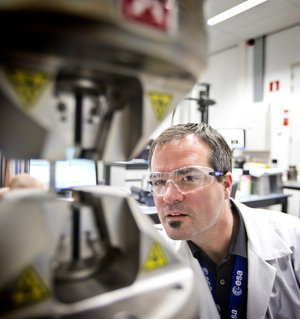Friction-stir welded titanium tank tested by X-ray
A section of titanium fuel tank for a satellite produced through a novel welding technique has been subjected to detailed X-ray analysis to check its robustness for use in orbit.
ESA’s Materials and Electrical Components Lab used its X-ray goniometer to assess the residual stresses in the welds made by ‘friction-stir welding’ – cheaper, faster, greener and potentially stronger than traditional welding.
“We’re shining a half-millimetre X-ray beam onto the surface of the weld and measuring how it is diffracted back,” explains metallurgist Adrian Graham.
“We observe a distinctive conical reflection pattern, based on diffraction of the crystalline structure of the metal, but any displacement due to residual stress will distort this shape.”

Fuel tanks such as this are at the heart of satellites and launcher upper stages, essential to store the highly energetic – and often corrosive – propellants used to shift orientation and position in space. A mission without fuel is essentially uncontrollable.
Last year, ESA worked with welding specialist TWI in the UK and Airbus Defence and Space to produce a titanium tank with friction-stir welding: a rotating tool was used to heat and soften the metal parts before mixing them together, like kneading dough, with no external heat source necessary.
Because less energy is used, the welding process inflicts less residual stress on joints than standard ‘fusion welding’ – molten welds will pull on surrounding metal as they solidify. The result is that tanks made with friction stir welds will suffer less distortion, ending up with material performance comparable to unwelded metal.

Friction-stir welding is today widely used to join aluminium components, but the reliable welding of titanium is a global first for the technique.
“Because titanium is so strong and resistant, different pieces need to be forged and machined separately before being fusion-welded together,” explains project leader Andy Norman. “The result has excellent resilience but has a long lead time – up to 12 months.
“Instead, the pieces of this tank could be cast directly from molten metal to nearer their final dimensions, with less follow-up machining.
“Because friction-stir welds have less residual stress we still end up with comparable levels of performance, but manufactured in weeks rather than months.”
This follow-up testing by the Mechanical and Electrical Components Lab at ESA’s technical centre in Noordwijk, the Netherlands, is seeking to quantify the resulting weld strength and develop validation standards for this process to aid its future adoption by the space industry.
The results will be compared to previous material testing performed by the Agency’s new Advanced Manufacturing Lab at the Rutherford Appleton Laboratory (RAL) in Harwell, Oxfordshire, directly adjacent to ESA's own UK facility, which employed RAL’s ISIS neutron diffraction instrument.
More traditional but destructive follow-up testing will also take place, involving drilling tiny holes around the welds to measure residual stress.

“It’s not enough to demonstrate new processes for space – to help encourage their take-up, we also need practical, affordable ways of validating them,” adds Adrian. “By cross-comparing these results we should get an idea of the optimal validation method.”
The project is supported through ESA’s General Support Technology Programme, bringing promising new technologies closer to the marketplace as part of the Agency’s Advanced Manufacturing cross-cutting initiative, helping the space sector to adopt novel production techniques.
“Residual stresses are a ‘black beast’ for all mechanical engineers, involved in ensuring that a structure can sustain the loads applied to it,” comments Tommaso Ghidini, heading ESA’s Materials and Processes Section.
“They are so dangerous because nobody can anticipate them precisely – but they are still there.
“Now, using this technique, our laboratory can precisely measure any residual stresses in all of our spacecraft and launchers parts, supporting the performances, reliability and ultimate safety of all ESA missions.”








